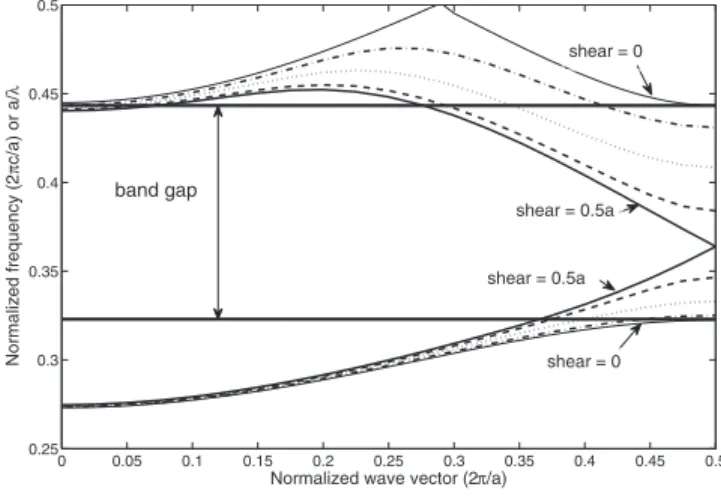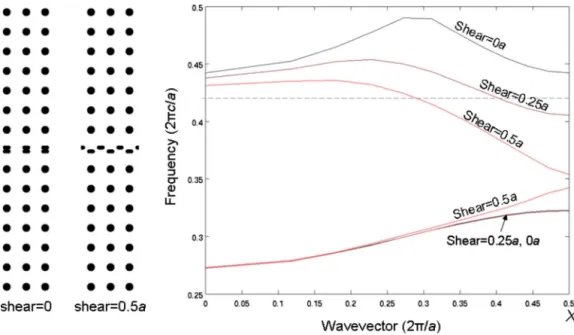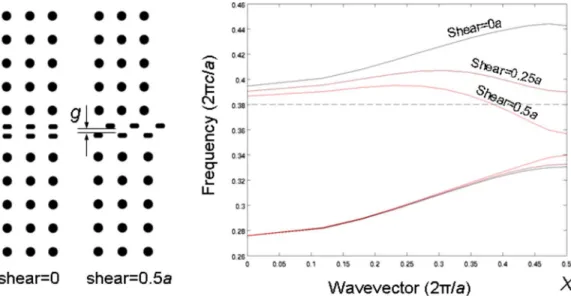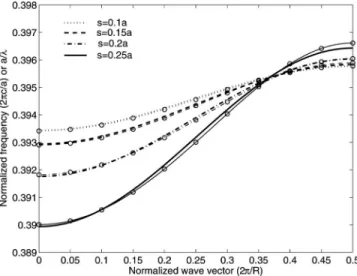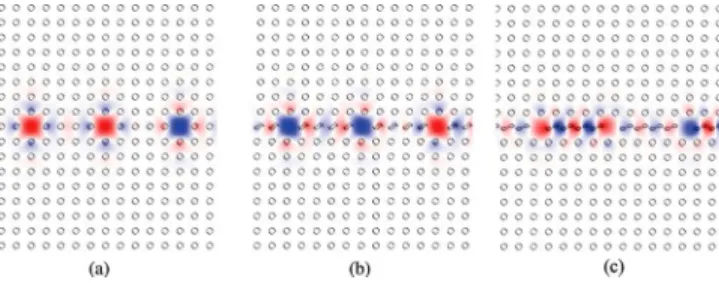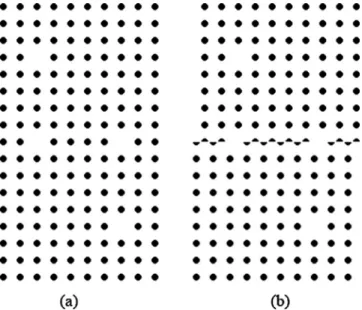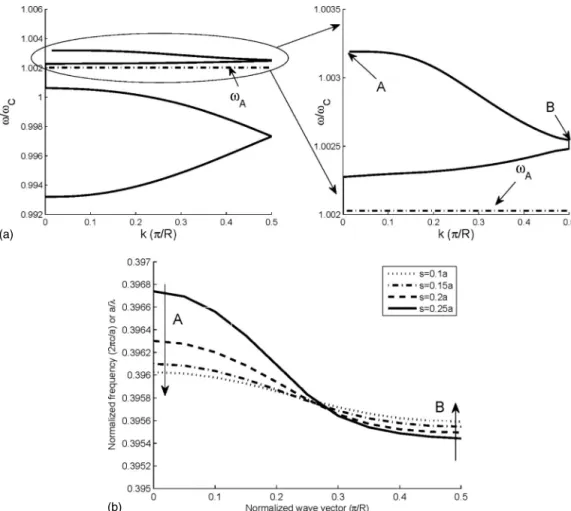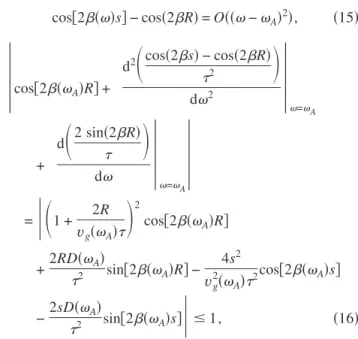photonic-crystal coupled-resonator optical waveguide
The MIT Faculty has made this article openly available.
Please share
how this access benefits you. Your story matters.
Citation
Tian, Kehan et al. “Dynamic group velocity control in a mechanically
tunable photonic-crystal coupled-resonator optical waveguide.”
Physical Review B 80.13 (2009): 134305. © 2009 The American
Physical Society
As Published
http://dx.doi.org/10.1103/PhysRevB.80.134305
Publisher
American Physical Society
Version
Final published version
Citable link
http://hdl.handle.net/1721.1/52458
Terms of Use
Article is made available in accordance with the publisher's
policy and may be subject to US copyright law. Please refer to the
publisher's site for terms of use.
Dynamic group velocity control in a mechanically tunable photonic-crystal coupled-resonator
optical waveguide
Kehan Tian,1,
*
William Arora,2Satoshi Takahashi,2 John Hong,3and George Barbastathis41IBM Semiconductor Research and Development Center, Hopewell Junction, New York 12533, USA
2Department of Mechanical Engineering, Massachusetts Institute of Technology, 77 Massachusetts Avenue, Cambridge,
Massachusetts 02139, USA
3Qualcomm, 5775 Morehouse Drive, San Diego, California 92121, USA
4Singapore-MIT Alliance for Research and Technology (SMART) Center, Block S16-06-17, 3 Science Drive 2,
Singapore 117543, Singapore
共Received 20 July 2009; published 29 October 2009兲
We describe a tunable slow light device based on a photonic-crystal with a mechanically adjustable coupled-resonator optical waveguide structure. The lateral energy confinement is implemented along a lattice shear defect with the group velocity actively controlled by shifting the shear along the defect interface over a distance of one crystal period. The group velocity tuning range can be anywhere from arbitrarily small 共determined by the waveguide structure兲 to near the value expected in bulk media. We present the theory and a demonstration共via simulation兲 of a device configuration that is realistic to fabricate and achieves a tunable range of group velocity spanning at least three orders of magnitude. The conditions for stopping the light are also discussed for different configurations.
DOI:10.1103/PhysRevB.80.134305 PACS number共s兲: 42.70.Qs, 42.82.Et
I. INTRODUCTION
Active control of the propagation characteristics of a light wave signal, e.g., speed, is important to the development of fast access optical memories and optically controlled delay lines in optical communication systems and optical comput-ing. We present a method of controlling the group velocity within a photonic-crystal waveguide by mechanically mov-ing part of the waveguide by submicrometer distances. Our proposed approach is unique in that it only engineers struc-ture configuration to control the group velocity. It does not require special media such as cold atomic gases,1,2electronic
transitions in crystalline solids,3or other nonlinear optical4,5
and thermal6effects. Thus, our approach is applicable at any wavelength range, particularly in the low loss window of optical devices and highly flexible because it is decoupled from nonlinear, thermal, and other effects that may be used in optical systems for other purposes.
Our concept is to laterally translate one-half of a photonic-crystal with respect to the other half. We have pre-viously shown that a shear-type defect within a two-dimensional共2D兲 photonic-crystal 关Figs.1共a兲and1共b兲兴
sup-ports guided modes, and furthermore, that the shear amount controls a number of mode properties including group veloc-ity and dispersion.7For pedagogical purposes, we review this
operational principle in Sec. II using a simplified structure which is impractical for standard fabrication techniques. In Sec. IIIof this paper, we introduce a design that is feasible from a fabrication perspective and also tolerant to the imple-mentation errors that are likely to arise from fabrication and operation.
Still, one of the main operational limitations of this struc-ture is the large group velocity dispersion. In Sec. IV we introduce a photonic structure, a shearable coupled-resonator optical waveguide共CROW兲. This is a CROW made within a photonic-crystal lattice by removing selected dielectric
struc-tures to form resonant cavities that are evanescently coupled. If the waveguide is made along a straight line, it is possible to shear it as shown in Figs.1共c兲and1共d兲. This effectively changes the coupling coefficients between resonant cavities and allows control over the group velocity of light. The prop-erties of eigenstates of sheared CROWs, such as symmetry and field distribution, are also investigated. Using finite-difference time-domain共FDTD兲 simulations, we demonstrate the process of tuning group velocity by changing the shear shift only. Mechanical displacements of only half a lattice constant are required 共submicrometer for optical applica-tions兲, and the device can operate at any frequency range.
The sheared CROW is limited by the minimum group velocity achievable with zero shear. Spacing the CROW cavities farther apart lowers the minimum group velocity, but may be practically limited by the size of waveguide required. In Sec. V we attempt to extend the tuning range until we create a flat band state 共zero group velocity兲 by using the resonant side cavity concept.8,9We are able to show that the
group velocity can be tuned over a range of three orders of magnitude. We also derive the possibility and conditions to achieve flat band state for different structures. Therefore, light entering this structure can be reversibly slowed by adia-batically modulating the amount of shear.
II. LOCALIZED PROPAGATION MODES IN PHOTONIC-CRYSTALS HAVING SHEAR
DISCONTINUITIES (Ref.7)
Consider a conventional 2D photonic-crystal consisting of dielectric rods in air on a square array with lattice constant a as shown in Fig. 1共a兲. For definiteness, we assume that the refractive index of the rods is 3.0 and the radius is r = 0.2a. The crystal has a TM 共magnetic field in plane兲 band gap which extends from frequency = 0.323⫻2c/a to
= 0.443⫻2c/a. This range corresponds to the canonical PHYSICAL REVIEW B 80, 134305共2009兲
free-space wavelength of light between 451 and 619 nm when a = 0.2 m. In this paper, we restrict our analysis to TM modes.
We presented a discontinuity in the middle row as shown in Fig. 1共b兲.7 The circular dielectric rods in the middle line
are cut in half so that the height h = r and the shear shift s ranges from 0 to 0.5a. The band diagram is computed by solving Maxwell equations directly in Fourier domain10 and
illustrated in Fig. 2. As the shear is increased, the bands above and below the band gap pull together, creating guided modes bound to the interface within the bulk of the crystal. Near the edge of the Brillouin zone, X 共k=/a兲, the modes flatten out and the group velocity is nearly zero共over a very small bandwidth兲. When s=0.5a, no flattening happens at the edge of Brillouin zone. This property is unlike the conven-tional photonic-crystal waveguides.
The guided modes in the shear waveguide have very low group velocity dispersion. Intuitively, this is because the lo-cal period along the shear plane has decreased to a/2 instead of a, breaking the condition for strong backward distributed Bragg reflection共DBR兲 coupling.29It is DBR that causes the
flattening of dispersion curves of conventional photonic-crystal waveguides.7,11 Moreover, the absence of dispersion
flattening curve eliminates the mode gap:12 guided modes
cover the full band gap.
III. ALTERNATE DESIGN FOR PRACTICAL IMPLEMENTATION
Fabricating a 2D photonic-crystal and shearing it as shown in Fig. 1共b兲 would be exceedingly difficult using a surface micromachining process. This is because of the re-quirement of making the cut on a free-standing structure that is capable of sliding laterally in a small region of a larger optical waveguide. In addition, the earlier design is poor be-cause it suffers from a number of problems that will reduce optical coupling and confinement such as vertical motion at the shear interface. An alternate approach is to fabricate a similar structure by folding or stacking a patterned mem-brane, using one of the approaches we have previously dem-onstrated such as ion-implantation stress13 or magnetically
actuated folding.14The concept is shown in Fig.3. It offers a
number of advantages over the original shear design. Several obvious ones are that cutting a photonic-crystal is not re-quired, the critical rows of half cylinders can be fabricated in separate locations, there is no need to shear the entire half crystal, possible vertical displacements are eliminated due to the folded membrane, the folded membrane acts as a super-strate共can be index matched to the substrate兲, and it is easier to integrate with the rest of the optical waveguide. Not shown in Fig.3 is the lateral displacement actuator required to make the membrane translate, but this can be achieved using a voltage actuated interdigitated comb drive or a mag-netic membrane translation scheme.15
In Fig. 4, we show that a photonic-crystal structure in which only half of the waveguide-row is translated functions
FIG. 1. Overhead view of 2D photonic-crystals comprising di-electric rods on a square lattice in air.共a兲 A perfect 2D crystal with lattice constant a and rod radius r = 0.2a. 共b兲 The same crystal, sheared through a row of cylinders at position h with one half of the crystal laterally translated by a distance s, in this case h = r and s = a/2. 共c兲 The same 2D crystal as in 共a兲 but with periodic CROW defects共missing rods every 5a兲. 共d兲 The CROW with a shear dis-continuity. As in 共b兲, half of the crystal is laterally translated by a distance s. 0 0.05 0.1 0.15 0.2 0.25 0.3 0.35 0.4 0.45 0.5 0.25 0.3 0.35 0.4 0.45 0.5
Normalized wave vector (2π/a)
Normalized frequency (2 π c/a) or a/ λ band gap shear = 0.5a shear = 0.5a shear = 0 shear = 0
FIG. 2. The two optical modes above and below the band gap of the crystal for increasing shear amounts, plotted along the X direc-tion in reciprocal space. When s = 0a, the structure is a perfect photonic-crystal and the modes form the expected band gap. As the amount of shear increases, the modes move within the band gap, and at s = 0.5a, all frequencies within the band gap can propagate along the shear while being confined by the bulk crystal. For an optical input centered around a particular frequency, for example, 0.42⫻2c/a, as s is tuned from 0.5 to about 0.2 the group velocity decreases from about 0.4c to nearly zero and then for s⬍0.2 the mode cannot propagate.
similarly to that of the original design共Fig.2兲 in which half
of the crystal is sheared. In addition, that half row may con-sist of ovals rather than half cylinders共as shown兲. Ovals are much simpler to fabricate than half cylinders. The main dif-ference between the band diagrams of Fig.2and4is that in Fig.4 the bands do not completely pull together at s = 0.5a. In fact, if the structure in Fig.4is modified so that the upper half of the photonic-crystal bulk is offset by 0.5a and fixed in that location, then when the half row reaches s = 0.5a the bands do indeed pull together. However, there is no need to do this for the purpose of slowing down the group velocity of light.
If this device were fabricated, it might suffer from mis-alignment or accidental displacement of the sheared half row causing a gap between the two half rows which may arise from misalignment of the half row, variation in half-row fea-ture sizes, or sidewall roughness. We analyzed this by simu-lating a gap of 0.2a, shown in Fig. 5. 共For an infrared photonic-crystal where a is approximately 500 nm; this cor-responds to a 100 nm gap, which is a realistic upper limit on
the amount of gap error.兲 Now even at zero shear there exists a guided mode within the band gap; however, the device must now operate around = 0.38⫻2c/a and can still be
tuned from a group velocity of near zero共at the edge of the Brioullin zone with a shear of about s = 0.3a兲 to near bulk at a shear of about s = 0.5a. Therefore, although gap error sig-nificantly alters the band diagram, it does not sigsig-nificantly affect the tunable range of the device. Interestingly, we found that the gap effect can be further mitigated with an improved design. This is done by changing the shape of the half-row features as shown in Fig.6, resulting in a device that can be tuned from a group velocity of near zero at s = 0.08a to near bulk at s = 0.5a. It is worth noting that this particular imple-mentation can realistically only be achieved using the mem-brane approach of Fig. 3, by placing one set of vertically oriented ovals on the folded membrane portion.
IV. TUNABLE COUPLED-RESONATOR OPTICAL WAVEGUIDE
A CROW consists of a periodic array of weakly coupled high-Q resonators, for example a periodic array of defects in a photonic-crystal, as shown in Fig. 1共c兲. If the resonators’ quality factor Q is sufficiently high and the coupling between resonators is sufficiently weak, the photons are well confined inside the resonators. Therefore, photons can propagate only by evanescently coupling from one resonator to its nearest neighbor. In direct correspondence with the description of electrons in a strong periodic potential,16 the guided modes
of a CROW can be described using the tight binding approxi-mation. A CROW is characterized by a nearly flat sinusoid dispersion relationship and can achieve group velocity smaller by several orders of magnitude than bulk material of the same average refractive index.17–20The guided modes of (b)
(a)
FIG. 3. 共Color online兲 Membrane folding approach to fabricat-ing a shear-tunable 2D photonic-crystal. 共a兲 The bulk crystal con-sists of silicon共high index兲 rods on an SiO2共low index兲 thin film. Within the bulk crystal, one row consists of half cylinders or other shaped defects. On the adjoining membrane, the complementary row of half cylinders is fabricated.共b兲 Once folded over, the SiO2
cladding is both above and below the 2D crystal for high confine-ment. Not shown are actuators that permit accurate lateral motion 共indicated by the arrows兲 to tune the translation amount.
FIG. 4.共Color online兲 共Left兲 Illustration of the half-row translation scheme with oval-shaped features along the half rows, in the position of s = 0a and s = 0.5a.共Right兲 Bandstructure of the two modes above and below the band gap for varying translation distance s of the upper half row. The dashed line indicates an example frequency共0.42⫻2c/a兲 at which the device might be used. At approximately s=0.2a the group velocity of light is near zero; as s increases to 0.5a the group velocity approaches that of a bulk共averaged index兲 medium.
DYNAMIC GROUP VELOCITY CONTROL IN A… PHYSICAL REVIEW B 80, 134305共2009兲
a CROW are well within the band gap and isolated from the continuum of modes that lie outside the band gap. This is in contrast with the previously shown design of Sec. II 共and
many other slow light waveguide designs兲21–26 which
achieve low group velocity at the edge of Brillouin zone or band edge but at the cost of a large group velocity dispersion and poor confinement of the fields. The dispersion curve of CROW can be simply characterized by the coupling coeffi-cientbetween nearest resonators, as done in Eq.共5兲 of Ref.
17. This equation states that the group velocity of a CROW is linearly proportional to the coupling coefficient, defined as the overlap of the eigenmodes of two adjacent resonators,
=
冕
d3r关⑀0共r − Rez兲 −⑀共r − Rez兲兴 ⫻ E⍀共r兲 · E⍀共r − Rez兲, 共1兲 where E⍀共r兲 is the eigenmode with mode frequency ⍀ of individual resonators along a straight line parallel to the z axis and the coordinate of the center of the n-th resonator isz = nR. ⑀0共r兲 is the dielectric constant of a single resonator while ⑀共r兲 is the dielectric constant of the entire CROW. Because the coupling coefficient depends on the exponential decay of evanescent waves between resonators in the cou-pling region, the imaginary part of the wave vector, I兵k其,
FIG. 5.共Color online兲 共Left兲 Illustration of how the gap error was simulated. 共Right兲 Bandstructure of the modes around the band gap for varying shears. The dashed line indicates an example frequency at which the device might be used.
FIG. 6. 共Color online兲 共Left兲 A modified tunable waveguide design using vertical dielectric ovals. One of the half rows is offset by a vertical gap g = 0.2a and then translated laterally from s = 0 – 0.5a for the simulation. 共Right兲 Bandstructure of the two modes above and below the band gap for varying shears at a fixed gap. At the indicated operating frequency of 0.41⫻2c/a, the group velocity can be tuned from slowest to fastest when s varies from 0.08a to 0.5a.
plays an important role in this integral. The amplitude of E⍀共r兲 at z=R 关the center of E⍀共r−Rez兲兴 decays as exp关−I兵k其·共R−a兲兴, where R−a is the length of the coupling region. Therefore,is proportional to exp关−I兵k其·共R−a兲兴. In turn, the group velocityvgis proportional to,17as we men-tioned earlier. This implies thatvg in a CROW can be tuned in one of two possible methods. The first method is to adjust the intercavity distance R; the second method is to adjust the imaginary part of the wave vector k. The imaginary part of k is proportional to the frequency difference between the edge of the frequency gap共i.e., band gap when s=0 or mode gap when s⫽0兲12 and the mode frequency of individual
resonators.12,27This difference in turn decreases as the shear shift increases from 0 to a/2, because of the shrinkage of the frequency gap as discussed in Sec.IIand also seen in Fig.7
of Reference. 7 Therefore, by actuation that specifies the shear between two half-infinite CROW lattices, we may alter the coupling efficiency between resonators and, hence, the group velocity.
We simulate the CROW structure of Figs.1共c兲and1共d兲at varying the shears using the parameters defined in the figure. In Fig. 7 we show the dispersion curve for the mode that appears within the band gap at varying amounts of shear. At
s = 0.25a, the slope of the dispersion curve is larger
indicat-ing larger group velocity; at s = 0.1a, the group velocity is lower. We fit the data共circles in Fig.7兲 to Eq. 共5兲 of Ref.17
using a least-squares cosinusoid fit as thick solid lines in Fig.
7, to estimate the coupling coefficient . These data, along with calculations of group velocity at k = 0.5⫻/R for each shear shift are listed in Table I.
In order to obtain an approximate analytical dependence of the group velocity on the shear shift, we calculated band diagrams for more shear shifts than these shown in Table I. The results, for shear shift ranging from zero to half the lattice constant, are shown in Fig.8. Polynomial fitting of the data in Fig. 8 revealed that the dependence of vg on s is quartic, given by vg=共7.6199s4+ 0.7188s2+ 0.0304兲c.
The group velocity can be tuned from 0.0304c with s = 0 to 0.336c with s = 0.4a. The discrepancy at shear shift larger than 0.4a is because of the failure of evanescent coupling in the coupling region. When the shear shift is larger than 0.4a, the mode gap becomes too small共Fig. 7 of Ref.7兲 to
accom-modate the guide modes of CROW,30so the guided modes of
CROW is coupled with the guided modes of sheared photonic-crystal. In this regime, the resonators are coupled by propagating rather than evanescent waves, invalidating the tight binding approximation. This situation looks more like a photonic-crystal waveguide than a CROW. This is verified in Fig. 9, which depicts the y component of the
TABLE I. Coupling coefficients and group velocities for sheared CROWs with different shear shifts. The dispersion curves are shown in Fig.7
Shear shift Coupling coefficient Group velocity Group velocity Group velocity
s 共Least-squares fit兲 共Direct difference兲 共FDTD兲
0.1a 3.0⫻10−3 0.0367c 0.0367c 0.0338c
0.15a 3.7⫻10−3 0.0466c 0.0454c 0.0448c
0.2a 5.4⫻10−3 0.0661c 0.0672c 0.0659c
0.25a 8.3⫻10−3 0.102c 0.103c 0.0998c
FIG. 7. The dispersion relation of the band within the band gap for a sheared CROW with different shear shifts s. Thin lines with circle symbols represent the spline fit with the exact simulation data, thick solid lines represent a least-squares cosinusoid fit. At k = 0.5⫻/R where the CROW systems have zero dispersion and maximum group velocity. CROWs operating at this point have far larger bandwidths than most other slow light devices.
FIG. 8. Group velocity of the guided mode in sheared CROsWs versus the shear shift s.
DYNAMIC GROUP VELOCITY CONTROL IN A… PHYSICAL REVIEW B 80, 134305共2009兲
electric field corresponding to the eigenstate of the sheared CROW for s = 0, 0.25, and 0.5a at k = 0.5⫻/R. The onset of lack of light confinement becomes clear by comparing the modes at each shear position. The fraction of electric field energy in the resonators in Fig. 9 is 59.5%, 50.5% and 28.2%, respectively. At the lower shear values, even though the resonators are of low refractive index they confine light strongly. This is why in Fig. 7the smaller shear shift simu-lations have better least-squares fits; the tight binding ap-proximation holds better. It is worth noting that the mirror symmetry about the z axis in the case of s = 0 is broken when
s = 0.25a or 0.5a. At zero shear shift, the eigenstate is
four-fold symmetric and has four symmetry axes 共mirror planes兲
ez, ex, 1/
冑
2共ex+ ez兲, and 1/冑
2共ex− ez兲 while at s=0.25a or 0.5a it is only two-fold symmetric and has no mirror sym-metry, as expected.We also simulated light propagation in sheared CROWs using FDTD to verify the preceding analysis. The first cavity was excited with a Gaussian pulse of time T0= 750a/c, cho-sen such that the pulse bandwidth would be 1/4 of the CROW guided mode bandwidth for s = 0.1a. This shear value corresponds to the slowest structure studied and we chose it to avoid dispersion contaminating our analysis of group ve-locity. We simulated structures having shears of s = 0.1a, s
= 0.15a, s = 0.2a, and s = 0.25a. From the fixed time snapshot of each simulation at t = 3850a/c, it is obvious that the pulse in a sheared CROW having s = 0.1a 关Fig.10共d兲兴 propagates slowest, while the pulse in a sheared CROW having s = 0.25a 关Fig. 10共a兲兴 propagates fastest. The spatial duration
of the pulses in the sheared CROW are L0= T0vg, meaning that the length of each pulse is proportional to its group velocity. Figure 10 also shows that the shortest 共slowest兲 pulse occurs with s = 0.1a, and longest共fastest兲 pulse occurs with s = 0.25a.
We also analyzed group velocity by measuring the time it took the pulse peak to propagate from plane A to plane B in the CROW of Fig.10 for different amounts of shear shift s = 0.1a, 0.15a, 0.2a, and 0.25a. This method of determining
vgis acceptable because dispersion is negligible for the cho-sen T0. The group velocities calculated from FDTD are listed in Table I and labeled as “x” in Fig. 8. Thus, the FDTD simulations demonstrate good agreement with the predic-tions from band diagrams and the polynomial fit ofvg vs s.
V. TUNABLE CROW WITH SIDE-CAVITIES
The simulated group velocity tuning range in Sec. IV, from 0.0304c to 0.336c, is not the limit of our tunable CROWs. In principle, we can achieve a tunable range down to arbitrarily small group velocities by increasing the inter-cavity distance. Beyond a limited extent this becomes im-practical because it requires enlarging the lateral dimensions of the device; in addition, dispersion becomes non-negligible as the intercavity distance increases. A better way is to place one or more side cavities in the neighborhood of each indi-vidual resonator in the CROW, as shown in Fig.11and first proposed in Ref. 8. In previous work on similar structures, the group velocity was reduced by modulating the refractive index of a small rod within the side cavities8,9and the
cavi-ties along the CROW.8 This shifts the resonance of each
cavity and allows one to tune the structure such that the light
FIG. 9. 共Color online兲 The electric field y component 共out-of-the-page兲 for the guided mode of the CROW 共a兲 with s=0 at k = 0.5⫻/R, 共b兲 with s=0.25a at k=0.5⫻/R, 共c兲 s=0.5a at k = 0.5⫻/R.
FIG. 10. 共Color online兲 Snapshots of the electric field in tunable CROWs at t=3850a/c. Gaussian pulses propagate inside tunable CROWs共a兲 with s=0.25a, 共b兲 with s=0.2a, 共c兲 with s=0.15a, and 共d兲 with s=0.1a. The duration time of the pulses is 750a/c. As we have observed earlier, the electric field is primarily concentrated within the resonators for these shear amounts; dispersion is negligible.
is in resonance with the side cavities and is trapped there, effectively in a flat band state.
Here, we aim to achieve a larger group velocity tuning range until a similar flat band state by shearing a CROW with side cavities. Instead of changing the resonance fre-quencies of the cavities, we are effectively changing the cou-pling between adjacent resonators in the CROW as well the coupling between side cavities and the CROW by shearing. The transmission matrix for a CROW section as the function of its length l is
T共l兲 =
冉
e−jl 0
0 e−jl
冊
, 共2兲where  is the Bloch wave vector of the CROW. It has a sinusoidal relationship to the frequency as
=C关1 −cos共R兲兴, 共3兲 whereC is the center frequency and is the coupling co-efficient between adjacent resonators. They are both func-tions of the shear shift, and can be obtained from the data in Sec.IV.
We assume that the side cavities have resonant frequency A, that does not change during shearing. The side cavities couple to the CROW with time constant, which is also the function of the shear shift. The direct coupling between the side cavities can be ignored. Therefore, the transmission ma-trix for the side coupling of the CROW to a side cavity can be expressed as TA=
冢
1 + j 共−A兲 j 共−A兲 − j 共−A兲 1 − j 共−A兲冣
. 共4兲The transmission matrix through an entire period can then be determined as
T共l兲 = TAT共R − s兲TAT共R + s兲, 共5兲 where s is the shear shift. The Bloch-Floquet condition is det共T−I兲=0. Since det共T兲=1,= exp共⫾jk2R兲 ifreduces to a pure phase shift 共e.g., for guided modes兲, where 2R is the length of one period and k corresponds to the Bloch wave vector of the entire system. Since can be calculated as =12共Tr共T兲⫾ j
冑
4 − Tr2共T兲兲, the band diagram of the system can be obtained as cos共2kR兲 =1 2Tr共T兲 = cos共2R兲 + cos共2s兲 − cos共2R兲 共−A兲22 +2 sin共2R兲 共−A兲 . 共6兲Guided modes exist in the frequency range where 兩12Tr共T兲兩 ⱕ1, while the system has mode gaps in the frequency range of兩12Tr共T兲兩⬎1. The typical band diagram for sheared CROW with side cavities is shown in Fig. 12共a兲. There are four guided modes and a gap in the vicinity of the resonance of side cavities. This mode structure arises from the coupling between guided modes from the sheared CROW and the resonant modes of the side cavities. As the shear decreases, the coupling coefficientbetween adjacent resonators in the CROW decreases while the coupling coefficient 1/between side cavities and the CROW increases. The decrease in the coupling coefficient between adjacent resonators in the CROW is equivalent to pulling point A in Fig.12downward while the increase in the coupling coefficient between side cavities and the CROW is equivalent to pushing point B upward. Therefore, the group velocity is tuned to a slower value.
By directly solving Maxwell equations in the Fourier domain,10we obtained the photonic bands from the structure
in Fig. 11 for different shear shifts, shown in Fig. 12共b兲. It proves our prediction from transmission matrix analysis. The group velocity can be tuned as low as⬃10−3c.
In order to achieve even lower group velocity until flat band, we can utilize different resonant frequencies for side cavities, e.g., design the side cavities of the lower and upper half to have different resonant frequencies, A andB, re-spectively. This can be achieved by leaving some material inside the side cavities and/or tuning the refractive index of left material. The transmission matrix through an entire pe-riod need then be modified as
T共l兲 = TAT共R − s兲TBT共R + s兲, 共7兲 where TB is given by the same formula as TA 共Eq. 共4兲兲, ex-cept replacing A with B. The band diagram can then be obtained similarly as cos共2kR兲 =1 2Tr共T兲 = cos共2R兲 + C+ −A + C− −B , 共8兲 where
FIG. 11.共a兲 A supercell of the photonic-crystal CROW with side cavities at the half shear position.共b兲 At the zero shear position. For these simulations, the entire half of the crystal is sheared as shown 共instead of a half-defect row兲.
DYNAMIC GROUP VELOCITY CONTROL IN A… PHYSICAL REVIEW B 80, 134305共2009兲
C⫾= ⫾cos共2s兲 − cos共2R兲 共A−B兲2
+sin共2R兲
. 共9兲
As shown in Fig. 13共a兲, the band diagram still has four guided modes in the vicinity of the resonances, but now with two gaps occurring aroundAandB. From Eqs.共8兲 and 共9兲, the guided mode betweenAandBdepends strongly on the dispersion relationship共兲 of the original CROW without side cavities. It is also illustrated in Fig.13共b兲where共兲 is tuned by changing the coupling coefficient between adja-cent resonators in the CROW 共following Eq. 共3兲兲 through
shearing. In this case, the group velocity can easily be tuned lower than in the case ofA=B, e.g., at least one order of magnitude lower in Fig. 13. Therefore, we can achieve a tunable range of group velocity spanning at least three orders of magnitude共⬃10−4c to⬃10−1c兲.
With deliberate design of A and B, the shearing can result in the group velocity tuning to even lower values until the flat band emerges at=A when
C+共A兲 = cos关2共A兲s兴 − cos关2共A兲R兴 共A−B兲2 +sin关2共A兲R兴 = 0; and 共10兲
冏
1 2Tr共T兲冏
=冏
cos关2共A兲R兴 +冏
dC+ d冏
=A + C−共A兲 A−B冏
=冏
冉
1 + 2R vg共A兲冊
cos关2共A兲R兴 + 2 共A−B兲冉
1 + R vg共A兲冊
sin关2共A兲R兴 − 2s 共A−B兲vg共A兲2 sin关2共A兲s兴冏
ⱕ 1, 共11兲 where vg= dd is the group velocity of the original sheared CROW without side cavities. It can be calculated as vg =CR sin共R兲 for our case. To achieve flat band at zero shift, Eqs.共10兲 and 共11兲 can be further simplified as
tan关共A兲R兴 = − 共A−B兲, 共12兲
(b) (a)
FIG. 12. 共a兲 Band diagram of sheared CROW with side cavities 共Fig.11兲 from transmission matrix calculation for s=0.1a. The center frequency and coupling coefficient between adjacent resonators of the CROW can be obtained from the data of Sec. IV as C = 0.3946共2c/a兲 and=0.003. The side cavity resonance frequency is A= 0.3954共2c/a兲, and the coupling rate is 1/=A/1200. 共b兲 Band
冏
冉
1 + 2Rvg共A兲
冊
+ 2 cos2关共A兲R兴
冏
ⱕ 1. 共13兲 From Eqs.共12兲 and 共13兲, we can see that the original CROWneeds to have negative group velocity to satisfy the flat band conditions for zero shift. Note that the requirement of nega-tive group velocity is not necessary for flat bands at other shear shifts. Negative group velocity is very common and easy to achieve for CROW systems with deliberate design, e.g., by tuning the intercavity distance.17
It is worth noting that similar flat band conditions can also be obtained from Eq.共6兲 when the side cavities of lower and
upper half have the same resonant frequency.
sin关2共兲R兴 = O共−A兲, 共14兲
cos关2共兲s兴 − cos共2R兲 = O共共−A兲2兲, 共15兲
冨
cos关2共A兲R兴 +冨
d2冉
cos共2s兲 − cos共2R兲 2冊
d2冨
=A +冨
d冉
2 sin共2R兲 冊
d冨
= A冨
=冏
冉
1 + 2R vg共A兲冊
2 cos关2共A兲R兴 +2RD共A兲 2 sin关2共A兲R兴 − 4s2 vg2共A兲2 cos关2共A兲s兴 −2sD共A兲 2 sin关2共A兲s兴冏
ⱕ 1, 共16兲 where D =dd22 is the dispersion parameter of the originalsheared CROW without side cavities.
If the side cavities of the lower and upper half have dif-ferent resonant frequencies and conditions共10兲 and 共11兲 are
satisfied, then flat band can be achieved at any value of shear shift. But from Eqs.共14兲–共16兲, we can see that when the side
cavities of the lower and upper half have the same resonant frequency, flat band can only be achieved at s = 0, and the following conditions have to be satisfied.
sin关2共A兲R兴 = 0, 共17兲
冏
1 + 2Rvg共A兲
冏
ⱕ 1. 共18兲
The same as A⫽B, it also requires that the original CROW has negative group velocity, that is true for the ex-ample in the Ref.8 although it is not discussed.
Therefore, the structure as presented is dynamically tun-able, and by adiabatically shearing should be able to coher-ently slow down, hold, and speed up an optical signal in the same fashion as shown in Refs. 8 and9 but by only modi-fying structure configuration.
VI. CONCLUSION
We have designed a slow light device with a mechanically tunable waveguide region to realize active control of the group velocity of light. The tuning range is over three orders of magnitude with low dispersion by means of a flat band side cavity configuration and may even exceed this amount with improvements to the basic design. This potentially al-lows one to reversibly slow down, store, and release a pulse of light without significant dispersion by simply shearing the crystal, as long as the shearing is done adiabatically. This capability and the ability to tune the group velocity hold promise for optical communications as well as classical and quantum optical information processing.
(b) (a)
FIG. 13. Band diagram of sheared CROW with side cavities 共Fig.11兲 of different resonant frequenciesA⫽Bfrom
transmis-sion matrix calculation.共a兲 s=0.2a. The center frequency and cou-pling coefficient between adjacent resonators can be obtained from the data of SectionIVasC= 0.3939共2c/a兲 and=0.0054. The side cavity resonance frequencies areA= 0.3953共2c/a兲 and B
= 0.3946共2c/a兲, respectively. The coupling rate is 1/=A/1400.
共b兲 s=0.1a⬃0.25a.
DYNAMIC GROUP VELOCITY CONTROL IN A… PHYSICAL REVIEW B 80, 134305共2009兲
*ktian@us.ibm.com
1L. V. Hau, S. E. Harris, Z. Dutton, and C. H. Behroozi, Nature
共London兲 397, 594 共1999兲.
2M. D. Stenner, D. J. Gauthies, and M. A. Neifeld, Nature
共Lon-don兲 425, 695 共2003兲.
3M. S. Bigelow, N. N. Lepeshkin, and R. W. Boyd, Science 301,
200共2003兲.
4K. Lee and N. M. Lawandy, Appl. Phys. Lett. 78, 703共2001兲. 5Y. Okawachi, M. S. Bigelow, J. E. Sharping, Z. Zhu, A.
Sch-weinsberg, D. J. Gauthier, R. W. Boyd, and A. L. Gaeta, Phys. Rev. Lett. 94, 153902共2005兲.
6Y. A. Vlasov, M. O’Boyle, H. F. Hamann, and S. J. McNab,
Nature共London兲 438, 65 共2005兲.
7K. Tian, G. Barbastathis, and J. Hong, Opt. Express 14, 10887
共2006兲.
8M. F. Yanik and S. Fan, Phys. Rev. Lett. 92, 083901共2004兲. 9M. F. Yanik, W. Suh, Z. Wang, and S. Fan, Phys. Rev. Lett. 93,
233903共2004兲.
10S. G. Johnson and J. D. Joannopoulos, Opt. Express 8, 173
共2001兲.
11H. A. Haus, Waves and Fields in Optoelectronics共Prentice-Hall
Englewood Cliffs, New Jersey, 1984兲.
12A. Mekis, S. Fan, and J. D. Joannopoulos, Phys. Rev. B 58,
4809共1998兲.
13W. J. Arora, S. Sijbrandij, L. Stern, J. Notte, H. I. Smith, and G.
Barbastathis, J. Vac. Sci. Technol. B 25, 2184共2007兲.
14A. J. Nichol, P. S. Stellman, W. J. Arora, and G. Barbastathis,
Microelectron. Eng. 84, 1168共2007兲.
15A. J. Nichol, W. J. Arora, and G. Barbastathis, 2007 IEEE/LEOS
International Conference on Optical MEMS and Nanophotonics 2007共unpublished兲 p. 189.
16N. W. Ashcroft and N. D. Mermin, Solid State Physics共Harcourt
Brace Jovanovich, Orlando, 1976兲.
17A. Yariv, Y. Xu, R. K. Lee, and A. Scherer, Opt. Lett. 24, 711
共1999兲.
18Y. Xu, R. K. Lee, and A. Yariv, J. Opt. Soc. Am. B 17, 387
共2000兲.
19H. Altug and J. Vuckovic, Appl. Phys. Lett. 84, 161共2004兲. 20H. Altug and J. Vuckovic, Appl. Phys. Lett. 86, 111102共2005兲. 21R. D. Meade, A. Devenyi, J. D. Joannopoulos, O. L. Alerhand,
D. A. Smith, and K. Kash, J. Appl. Phys. 75, 4753共1994兲.
22A. Mekis, J. C. Chen, I. Kurland, S. Fan, P. R. Villeneuve, and J.
D. Joannopoulos, Phys. Rev. Lett. 77, 3787共1996兲.
23S. G. Johnson, S. Fan, P. R. Villeneuve, J. D. Joannopoulos, and
L. A. Kolodziejski, Phys. Rev. B 60, 5751共1999兲.
24S. G. Johnson, P. R. Villeneuve, S. Fan, and J. D. Joannopoulos,
Phys. Rev. B 62, 8212共2000兲.
25S. Y. Lin, E. Chow, V. Hietala, P. R. Villeneuve, and J. D.
Joan-nopoulos, Science 282, 274共1998兲.
26M. Notomi, K. Yamada, A. Shinya, J. Takahashi, C. Takahashi,
and I. Yokohama, Phys. Rev. Lett. 87, 253902共2001兲.
27P. Yeh, Optical Waves in Layered Media 共Wiley, New York,
1988兲.
28A. Konig and N. D. Mermin, Phys. Rev. B 56, 13607共1997兲. 29Based on group theory, sheared photonic-crystal has a
nonsym-morphic space group which can provide this additional degen-eracy at k = 0.5共2/a兲.28
30Although the mode gap for s⬎0.4a is too mall for the guided
modes of CROW, they are still well inside the band gap of perfect photonic-crystals. Therefore, the modes of individual resonators delocalize only along the shear plane, but not verti-cally in the entire photonic-crystal because the modes are con-fined along the shear plane by the mode gap while concon-fined in other directions by the band gap.
